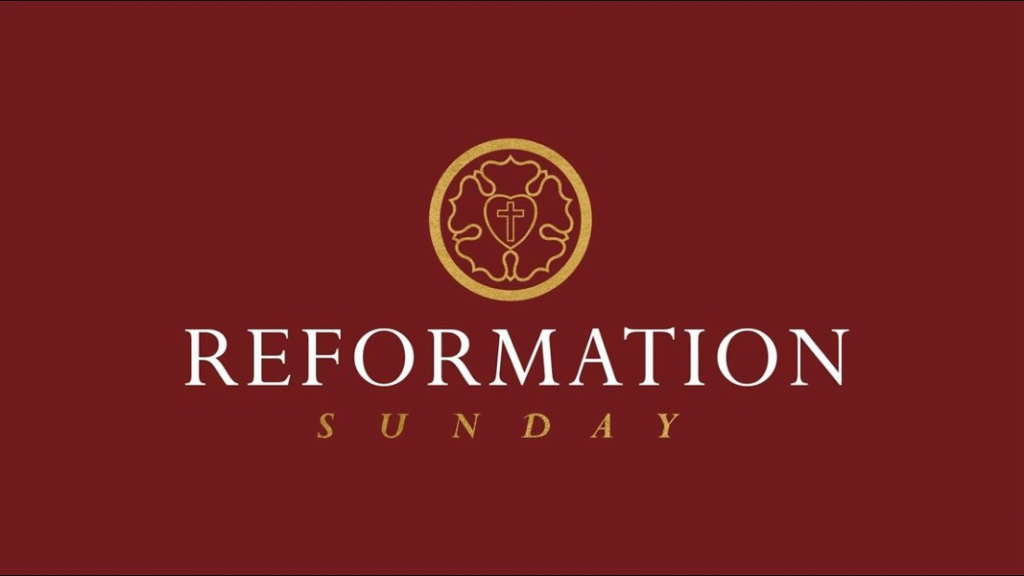Last Sunday (Reformation Sunday), we celebrated the 508th anniversary of the beginnings of the Protestant Reformation. Want to know more? Read on?

In October 1517, the German monk Martin Luther planned a debate about the practice of selling indulgences. No one came, so he sent his theses directly to Cardinal Albrecht of Brandenburg, Elector and Archbishop of Mainz. At the same time, he is said to have nailed these 95 theses to a Wittenberg Church door which served as a kind of billboard at that time. The move unleashed a debate that shook that foundation of the Church. To understand the tremor that Luther unleashed with his 95 theses, we have to go back to the era he lived in. In the late Middle Ages and beginning of the modern era, the Christian faith was dominated by the Roman Catholic Church. The Church’s dogma and rules dictated people’s lives, and God was seen as a judgmental figure who never let a mistake go unpunished. Events that couldn’t be explained – like personal tragedies, bad harvests or even wars – were viewed as the consequences of a pact with the devil. Those thought to have entered into such deals were usually burned at the stake. So what were the factors that contributed to Luther’s change of heart and his desire for reform within the church? Apart from God working mightily through His Spirit, consider these circumstances he knew in his earlier years.
That bolt of lightning: Luther was born in Eisleben in 1483 as the son of a miner. In 1501, he began his studies at the University of Erfurt. Four years later, he completed his Masters degree and then began studying law. Then something life-changing happened. In July 1505, he was caught in a big storm and was struck by lightning. Faced with the prospect of death, he feared having to face God unprepared, so he called to Saint Anna, the patron saint of miners, and pledged to become a monk. Less than a fortnight later, Luther knocked on the door of the Augustinian cloister in Erfurt and asked to be accepted into the order.
Early life as a monk: Driven by his search for a merciful God and fear of missing out on life after death, Luther saw an opportunity to experience a fulfilled life inside the walls of the monastery. From the beginning, the young monk was conspicuously obedient. He prayed for six hours a day and fasted; he practiced self-reflection, mortification and confession. Later, Luther would say about his life in the cloister, “If ever anyone has ever managed to get into heaven by being a monk, I wanted to do that too.” Less than two years after entering the monastery, Luther became a priest in 1507. Theological teaching was at the centre of his studies, which he threw himself into with zeal.
First experience of the selling of indulgences: In 1510, Luther was sent to Rome on business by his Augustine order. The trip would prove pivotal. The Curia was struggling financially due to the expensive construction of St. Peter’s Basilica. To raise money, the church leaders introduced the selling of indulgences. The congregation was told they could attain the forgiveness of sins by committing good deeds – or paying the Church. Prices were set according to income, and even those who’d already died could allegedly be rescued from the fires of hell if their relatives coughed up a few coins. It wouldn’t be until much later that Luther would take a critical view on the practice he had witnessed.
Search for acceptance by God: In 1512, Luther – already highly respected by his colleagues and superiors – earned his doctorate in theology and became a professor at the University of Wittenberg. Nevertheless, Martin Luther was still searching for a merciful God and continued to ask the question: What must I do to be approved by God? None of the Church’s rituals or rules was able to answer this question. Luther continued fervently to read the Bible and was particularly moved by the Apostle Paul’s letter to the early Roman church, where he read about justification by the blood of Jesus Christ. The theologian gradually understood what would become the core of the Reformation: God is not just a just judge, but also a father who loves the people he created and who sent his son to pay the price for the sin that was separating them from him. As Luther discovered in the Bible, anyone who believes in God and his son Jesus Christ is given the free gift of justification before the Almighty. The monk had finally found the answer to his question.
His four pillars of faith: Through his study of the Bible, Martin Luther developed four key theological pillars. The first is the Holy Scripture. He saw the Bible as the only benchmark of truth, while the Church at the time also relied on additional texts written by the pope and the synod. Secondly, salvation only comes through God’s grace and not by good works. This belief made the selling of indulgences obsolete. Thirdly, Luther concluded that Jesus Christ, through his death on the cross, which paid the penalty for all sin, is the only bridge between humanity and God. Finally, Luther believed we are saved by faith alone. “Christian life is entirely based on faith,” he said. “By faith, Christ lives in us and is one with us. By faith in Christ, Christ’s righteousness becomes our righteousness and what is his, becomes ours.” These beliefs revolutionized the relationship between God and people. Realizing they were acceptable to God by his grace and their faith alone, people could approach him directly without the help of an intermediary priest. Consequentially, the Church lost its power with Luther’s teachings and its hierarchies began to crumble. But while his work was revolutionary, Luther himself believed he was simply reinstating old, forgotten principles and apostolic teachings rather than expressing new and unwelcome beliefs.

And now?…. Here we are more than 500 years later and the Reformation’s effects have not diminished. The Protestant church continues to grow all over the world and we are glad to belong to it. However many aspects addressed by Luther at the time still remain, dividing professing Christians into Roman Catholic and Protestant. These can be summarised by the following eight points.
Understanding of the Bible: Roman Catholics and Protestants have distinct views on the meaning and the authority of the Bible. For Protestant Christians, Luther made clear that the Bible is the “Sola Scriptura,” God’s only book, in which He provided His revelations to the people and which allows them to enter in communion with Him. Roman Catholics, on the other hand, do not base their beliefs on the Bible alone. Along with the Holy Scripture, they are also bound by their traditions.
Understanding the church: Roman Catholics and Protestants have a different view on the nature of the church. The word “catholic” means “universal,” and the Roman Catholic Church sees itself as the only true church worldwide, under the leadership of the pope. In contrast, the Protestant Churches do not make up one visibly united Church. There are many, many different denominations around the world. Officially, all of these many churches are considered equal.
The pope: Roman Catholics see in the pope the successor of the Apostle Peter, the first head of their Church, who was appointed by Jesus. The papal office is justified by an allegedly unbroken chain of consecrations, ranging from the first century to the present. Protestants maintain that this contradicts the teaching of the Bible.
Understanding of the office: This continuous chain, known as the apostolic succession, is significant for spiritual offices in the Roman Catholic Church by which bishops, priests and deacons receive a lifelong seal of God giving them sacramentalauthority over Catholic laypeople. While setting apart individuals to preach the Word, the Protestant church does not believe in apostolic succession and also teaches that all believers may serve God in a wide variety of callings in life.
Celibacy: All main world religions integrate in some way the concept of celibacy, the vow of abstaining from marriage and sexual relations, and the Roman Catholic and Protestant churches are no exception. In the Roman Catholic Church, celibacy is obligatory for priests as a symbol of the undivided succession of Christ. The Protestant Church rejects this obligation for its gospel ministers. In 1525, Luther wrote that, ‘his marriage would please his father, rile the pope, cause the angels to laugh, and the devils to weep.”
Eucharist or Lord’s Supper: The Roman Catholics’ views on the spiritual office are reflected in their mass, when, once consecrated by a priest in the name of Jesus, the bread and wine become the body and blood of Christ. Non-Catholics may not participate in Communion. Protestants, hold that the elements represent the body and blood of Jesus and all who profess faith are invited to participate.
Sacraments: In the Roman Catholic Church there are seven solemn rites, called sacraments: baptism, confirmation, the Eucharist, matrimony, penance, holy orders and extreme unction. The church believes these sacraments were instituted by Jesus and that they confer God’s grace. Most Protestant churches only practice two of these sacraments: Baptism and the Lord’s Supper. They are perceived as symbolic rituals through which God reminds us of the Gospel.
Marian dogmas and the worship of Saints: The Roman Catholic Church reveres Mary, the mother of Jesus, as “Queen of Heaven.” However, there are few biblical references to support the Catholic Marian dogmas – which include the Immaculate Conception, her perpetual virginity and her Assumption into heaven. Though Protestants believe Mary was the mother of Jesus, unlike Roman Catholics, they do not venerate her or any other ‘saints’ but teach that we must pray directly to God.
Praise God for the work begun in the Reformation and pray that it ever would continue!
Sola Scriptura (“Scripture alone”)
Sola Fide (“Faith alone”)
Sola Gratia (“Grace alone”)
Solus Christus (“Christ alone”)
Soli Deo Gloria (“To the glory of God alone”)
Acknowledgements:
https://www.dw.com/en/why-martin-luther-was-an-unsuspecting-revolutionary/a-36161020
https://www.dw.com/en/the-main-differences-between-catholics-and-protestants/a-37888597




